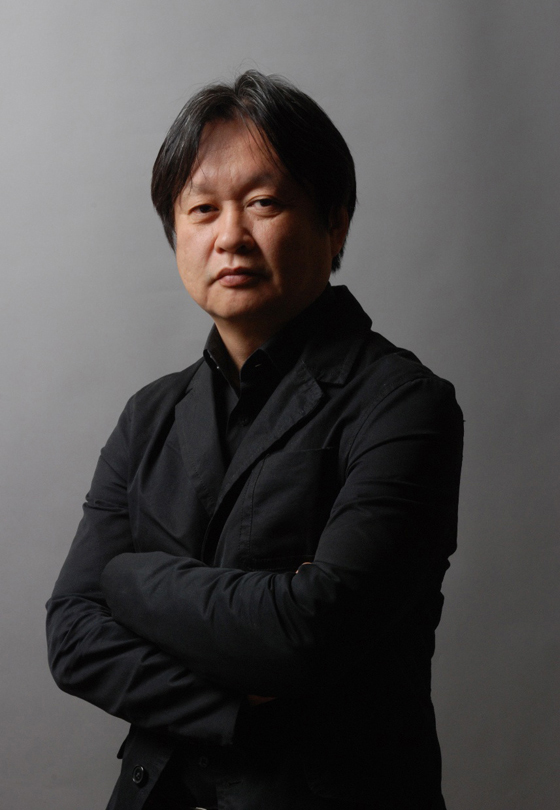The Milan Conversations: Part II – James Irvine and Naoto Fukasawa
Scritto da Simon Keane-Cowell
Zürich, Svizzera
01.05.10
In this second installment of the Milan Conversations – a series of discussions held at this year's Salone del Mobile with some of the most celebrated designers working internationally – Architonic talks to British designer and long-time Milanese James Irvine about the privilege of, and the sensitivities involved in, working for a heritage brand like Thonet, and to master of formal simplicity and beauty Naoto Fukasawa about the relation between mind, body and design.
A chair from Naoto Fukasawa's solid-wood '130' series for Thonet, launched at this year's Milan Salone del Mobile
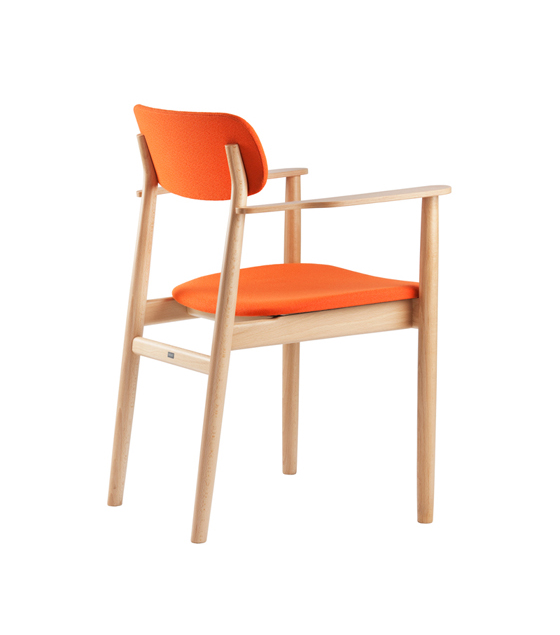
A chair from Naoto Fukasawa's solid-wood '130' series for Thonet, launched at this year's Milan Salone del Mobile
×.....
JAMES IRVINE – 'Luckily, man is creative'
What's your take on the furniture fair as someone who's lived and worked in Milan for a long time, as a Milanese? Do you think the city relies on that creative injection from outside?
People talk about design in Italy but I always like to talk about industry in Italy in the sense that so much of what's happening started from the incredible companies we have here – the historic companies, of course, and all the new, small companies – and that's the reason why Milan has become what it is, why it's the centre, why an event like this happens here. Because it's surrounded by industry of extremely high quality. And above all it's industry that's privately owned, so the decision-making isn't done by marketing managers, as might be the case in America. Decisions are made by Mr Busnelli or Mr Cappellini, or whatever. And I think that makes a huge difference. Privately owned companies.
James Irvine: 'The more crazy stuff there is out there, the more my job becomes easier. It gives me a raison-d'etre.'

James Irvine: 'The more crazy stuff there is out there, the more my job becomes easier. It gives me a raison-d'etre.'
×Is there a particular set of responsibilities that come with working with a design manufacturer that has such a long heritage?
Well, there are advantages and disadvantages. Some companies can be weighed down by their history. It's quite a tough job to understand what you can take from the past and how you can change. Because, obviously, the brand value is enormous in the name, in the collective memory of what a company like Thonet is. You say the word 'Thonet' and everyone thinks of the bentwood chair. Funnily enough, most people don't think of Breuer's cantilever chair, which, historically, is a very important part of Thonet.
It's interesting for me to play this balancing act between the past and the future. I wouldn't say I want Thonet to be a company that's necessarily radical. But continually to freshen it up and to make the products relevant to today. And so many of them are always relevant because they are some of the greatest inventions in the history of design. The '14', the bentwood chair, is an iconic product, which is forever. It's one of the most genius pieces of work in wood. Unbeatable work in many ways.
And, of course, Marcel Breuer's tubular-steel work, too.
Exactly. It's quite scary. (Laughs.)
Design manufacturer Thonet's stand at the 2010 Milan Salone del Mobile, designed by James Irvine, who, among his work for other clients, is the company's creative director
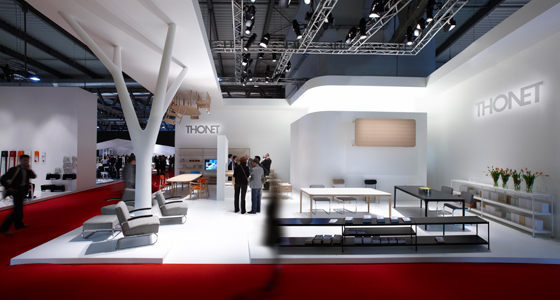
Design manufacturer Thonet's stand at the 2010 Milan Salone del Mobile, designed by James Irvine, who, among his work for other clients, is the company's creative director
×It must be unnerving for sure. I think it proves how radically discontinuous this type of design language was when it first appeared. In the case of the '14', 150 years on it still has meaning. With this in mind, how difficult was it to rethink the chair as part of the recent Muji/Thonet collaboration?
It was unbelievable. One of the most difficult things I've ever had to design. The only thing I could do was to remove some bits to make it simpler. In press terms, it was extremely successful. But I had to tread lightly. There's the danger of hubris. You're playing with fire. But I had the advantage that I consult to Muji and am also art director of Thonet, so I had a foot in both camps and was able to make them both happy at the same time. I'm very proud of that. Seems such a small job, but actually it was huge. Nobody has said anything bad about it, luckily. (Laughs.)
Well, I think a process of removing physical elements from an existing design can be just as difficult as adding to it.
If you think about it, I just put in the straight slat. The slat was an homage to Hoffmann. Then I removed the ring underneath. Then I designed a table to go with it, which is a blow-up of the front leg of the '14', with a top the thickness of the chair seat blown up. And this table had never existed but seems like such a logical addendum. It was so interesting to 'find' the table for the '14'. Totally new and totally old.
As part of a collobration between Muji and Thonet, James Irvine's 2009 revisiting (left) of the classic 'No. 14' bentwood chair (right), which first appeared in 1860
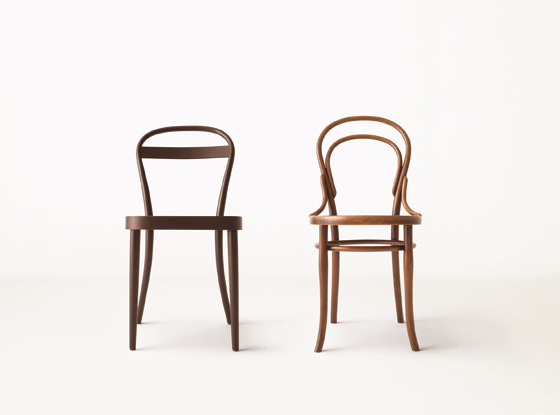
As part of a collobration between Muji and Thonet, James Irvine's 2009 revisiting (left) of the classic 'No. 14' bentwood chair (right), which first appeared in 1860
×It's interesting that we're talking about historical design pieces because here we at the Milan furniture fair, surrounded by a surfeit of products. Each year there's more and more new stuff. How do you feel about the rate at which the industry seems to be launching new products?
Well, everybody's got to work. Luckily, man is creative.
But might classic, historical designs, having proven their value, their relevance, have a role to play, perhaps, in terms of counteracting the design culture we've created which fetishises the 'new'?
I think a lot of classic pieces have become icons. And they are a joy to the eye because people actually feel comfortable with them, they know them. I think there is always a value in maintaining the quality of a company like Thonet and respecting those icons from the past and continuing to make them well. Vitra does the same with Eames. These things are forever. They're never going to disappear. As long they are still meaningful and liveable with, and in no way damaging the environment, as many things do.
The problem is when companies get desperate and launch some novelties because they want to shout. That's when things get silly. But I have no objection. Everyone can do what they like. Actually, the more crazy stuff there is out there, the more my job for this company becomes easier. (Laughs.) It gives me a raison-d'etre, which is nice.
James Irvine designed a table to accompany his simplification of Thonet's classic bentwood chair: 'It was so interesting to "find" the table for the "No. 14". Totally old and totally new,' Irvine tells Architonic.
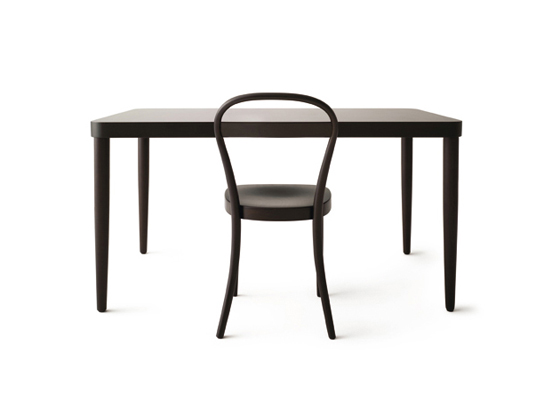
James Irvine designed a table to accompany his simplification of Thonet's classic bentwood chair: 'It was so interesting to "find" the table for the "No. 14". Totally old and totally new,' Irvine tells Architonic.
×I think we, the design press, are responsible to a large extent for that craziness. The question most often heard at any design fair is the one posed by the journalists at every stand: 'Can you tell me what's new?'
Well, yes. It's free advertising. But don't worry about it.
I won't too much. (Laughs.)
Think about other industries. Electronics, for example. It's continuous obsolescence. Those forms of consumerism are perhaps far more worrying. And there's a lot to worry about in the drop of quality of things because people are talking about money all the time. For me, I don't like the idea that furniture is seen as something that you can consume and throw away, which is really nasty ecologically. I like the idea that if you buy something, you keep it. You don't buy it with the mindset that maybe after five years you throw it out.
I think we can all get on board with that. James, thanks very much for your time.
.....
NAOTO FUKASAWA – 'A chair is just a chair'
I've used a Mac for years, but when I had to buy a PC recently I found it very difficult to commit to a product until I saw your recent notebook for Samsung. For me, this says something about the value with which you imbue your work. Your products clearly avow their utilitarian function and yet seem to transcend that function in terms of their form and aesthetics, which are poetic and timeless.
Thank you. So do you look at my chair (for Thonet) and my laptop in the same kind of way?
Naoto Fukasawa: 'The mind can lie. Bodies are more honest.'
I do. They both display a real consideration. What is your relation to style, would you say? Do you think you have a conscious style? Can one be style-less, or is that in itself a stylistic expression?
You have both a chair and a laptop in your home. Both objects exist in the same world. But the industries – the electronics and furniture industries – are totally different. A designer who designs a PC normally only ever designs electronics. But I don't like that. I always think the PC lives in your home along with other objects. The chair, the TV, the mobile phone can be mixed. Harmonised. They become naturally the same for me.
Do emotions play a part in the objects you design, insofar as inviting the user to form an emotional relationship with your products?
I see the human more in terms of the body than the mind. If I focus too much on the mind, to try and connect with it, things get confused. Everyone's mind is different. But if I focus on the body, on the fact that it's natural and inevitable how we interact with objects, it's easy to see quite a clear relationship between the object and the user. So I usually ignore the mind. That's why while you're using a computer you don't usually think about the computer. While you're using a chair you never think about a chair. That's a more natural interaction. The mind can lie. Bodies are more honest.
View of chair from Naoto Fukasawa's solid-wood '130' series for Thonet, launched at this year's Milan Salone del Mobile
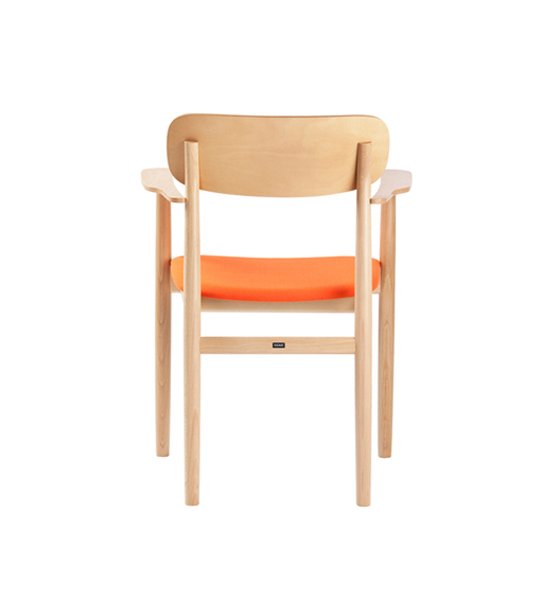
View of chair from Naoto Fukasawa's solid-wood '130' series for Thonet, launched at this year's Milan Salone del Mobile
×That's an interesting way of seeing things. I'd like to ask you your thoughts on attending a fair like Milan, where a huge amount of new products are presented every year. Has it all become too much? The rate at which the industry seems to develop and launch new objects seems to be showing no sign of abating. Can we justify all of this stuff?
You always have some images in your mind of objects that you want in your life. It's like a single, vertical line. Some designers create work that doesn't sit on this centre line but is more left or right of it. Some designers are a long way from this line. The Salone del Mobile is a place where a lot of designers try to move as far away from the line as possible. But sometimes your mind really and naturally finds the centre line. And I really want to be there, in the centre. People always shift, but I focus on the centre. That's what makes you happy.
Naoto Fukasawa's '1131' extendable table for Thonet
You're talking then about objects that are really needed. I think your designs display a wonderful sense of harmony – they are objects that people want to live with for a long time, that they don't want to get rid of. Their aesthetic function seems to be as important as their technical one.
I really care about the relationship between the object and the human. You are centre of your life. All of my objects have to take a little step back from that, be in the background. If the product is too much in the centre with you, it's a design collection, not a tool that you're spending time with in your life. There are designers who really want to design for design collectors. That's not true for me. A chair is just a chair.
Maybe it's only us who inhabit this industry who think the chair has more importance than it perhaps does.
True. True.
It's been a pleasure talking to you, Naoto.
.....





